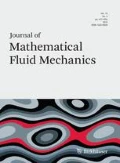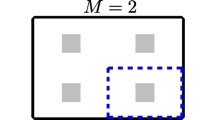Abstract
In this article we study a system coupling the incompressible Navier–Stokes equations with an elastic structure governed by a damped wave equation in a two dimensional channel with periodic boundary conditions. The elastic structure is located at the upper boundary of the domain occupied by the fluid. The domain occupied by the fluid depends on the displacement of the elastic structure, and therefore it depends on time. We prove that this coupled system may be stabilized around the steady state zero, at any exponential decay rate, by a Dirichlet control acting in the lower boundary of the fluid domain.
Similar content being viewed by others
References
Badra, M., Takahashi, T.: Feedback boundary stabilization of 2D fluid-structure interaction systems. https://hal.archives-ouvertes.fr/hal-01370000 (2016)
Bensoussan, A., Da Prato, G., Delfour, M., Mitter, S.K.: Representation and control of infinite dimensional systems. Systems and Control: Foundations & Applications, 2nd edn. Birkhäuser Boston, Inc., Boston (2007)
Burns, J.A., King, B.B.: A note on the mathematical modelling of damped second order systems. J. Math. Syst. Estim. Control 8, 1–12 (1998)
Chen, G., Russell, D.L.: A mathematical model for linear elastic systems with structural damping. Q. Appl. Math. 39, 433–454 (1982)
Chen, S.P., Triggiani, R.: Proof of extensions of two conjectures on structural damping for elastic systems. Pac. J. Math. 136, 15–55 (1989)
Casas, E., Matéos, M., Raymond, J.-P.: Penalization of Dirichlet optimal control problems. ESAIM Control Optim. Calc. Var. 15, 782–809 (2009)
Fabre, C., Lebeau, G.: Prolongement unique des solutions de l’equation de Stokes. Commun. Partial Differ. Equ. 21(3–4), 573–596 (1996)
Grandmont, C., Lukáčová-Medvid’ová, M., Nečasová, S.: Mathematical and numerical analysis of some FSI problems. Fluid-structure interaction and biomedical applications, pp. 1–77, Adv. Math. Fluid Mech. Birkhäuser/Springer, Basel (2014)
Grubb, G., Solonnikov, V.A.: Boundary value problems for the nonstationary Navier–Stokes equations treated by pseudo-differential methods. Math. Scand. 69(2), 217–290 (1991). (1992)
Kato, T.: Perturbation theory for linear operators, Corrected Printing of the Second Edition. Springer, Heidelberg (1980)
Lequeurre, J.: Existence of strong solutions for a system coupling the Navier–Stokes equations and a damped wave equation. J. Math. Fluid Mech. 15, 249–271 (2013)
Matignon, D., Ndiaye, M., Raymond, J.-P.: Feedback stabilization around a non zero stationary solution of a 3D fluid-structure model with a boundary control (in preparation)
Ndiaye, M., Matignon, D., Raymond, J.-P.: Feedback stabilization of a 3D fluid-structure model with a boundary control, In: Proceedings of the 21st International Symposium on Mathematical Theory of Networks and Systems, July 7–11, University of Gröningen, Gröningen (2014)
Nguyen, P.A., Raymond, J.-P.: Boundary stabilization of the Navier–Stokes equations in the case of mixed boundary conditions. SIAM J. Control Optim. 53, 3006–3039 (2015)
Pazy, A.: Semigroups of Linear Operators and Applications to Partial Differential Equations. Applied Mathematical Sciences, vol. 44. Springer, New York (1983)
Raymond, J.-P.: Feedback stabilization of a fluid-structure model. SIAM J. Control Optim. 48, 5398–5443 (2010)
Raymond, J.-P.: Stokes and Navier–Stokes equations with nonhomogeneous boundary conditions. Ann. Inst. H. Poincaré Anal. Non Linéaire 24, 921–951 (2007)
Raymond, J.-P.: Stokes and Navier-Stokes equations with a nonhomogeneous divergence condition. Discrete Contin. Dyn. Syst. Ser. B 14(4), 1537–1564 (2010)
Raymond, J.-P., Vanninathan, M.: A fluid-structure model coupling the Navier-Stokes equations and the Lamé system. J. Math. Pures Appl. (9) 102(3), 546–596 (2014)
Rudin, W.: Real and Complex Analysis, McGraw-Hill, New York (1966)
Triggiani, R.: Regularity of some structurally damped problems with point control and with boundary control. J. Math. Anal. Appl. 161, 299–331 (1991)
Triggiani, R.: Unique continuation from an arbitrary interior subdomain of the variable-coefficient Oseen equation. Nonlinear Anal. 71, 4967–4976 (2009)
Turek, S., Hron, J., Mádlikík, M., Razzaq, M., Wobker, H., Acker, J.-F.: Numerical simulation and benchmarking of a monolithic multigrid solver for fluid-structure interaction problems with applications to hemodynamics. In: Bungartz, H.-J., et al. (eds.) Fluid Structure Interaction II. Lecture Notes in Computational Science and Engineering, pp. 193–220. Springer, Berlin (2010)
van Zuijlen, A.H., Bijl, H.: Multi-Level Accelerated sub-iterations for fluid-structure interaction. In: Bungartz, H.-J., et al. (eds.) Fluid-Structure Interaction II. Lecture Notes in Computational Science and Engineering, pp. 1–25. Springer, Berlin (2010)
Author information
Authors and Affiliations
Corresponding author
Additional information
Communicated by M. Tucsnak
The authors are members of an IFCAM-project, Indo-French Centre for Applied Mathematics-UMI IFCAM, Bangalore, India, supported by DST-IISc-CNRS- and Université Paul Sabatier Toulouse III. The research of D. Maity was supported by the Airbus Group Corporate Foundation Chair in Mathematics of Complex Systems established in TIFR, Bangalore.
Rights and permissions
About this article
Cite this article
Maity, D., Raymond, JP. Feedback Stabilization of the Incompressible Navier–Stokes Equations Coupled with a Damped Elastic System in Two Dimensions. J. Math. Fluid Mech. 19, 773–805 (2017). https://doi.org/10.1007/s00021-016-0305-2
Accepted:
Published:
Issue Date:
DOI: https://doi.org/10.1007/s00021-016-0305-2



